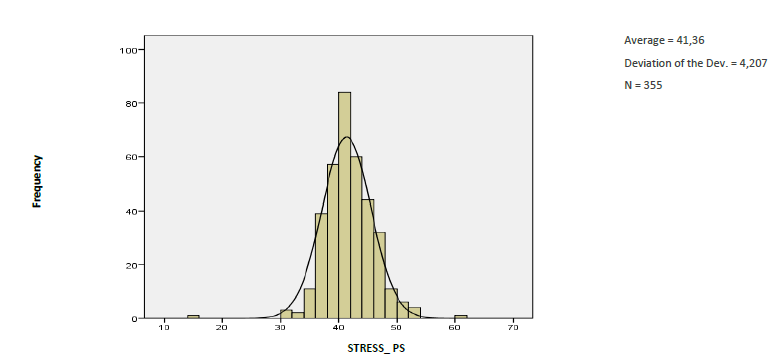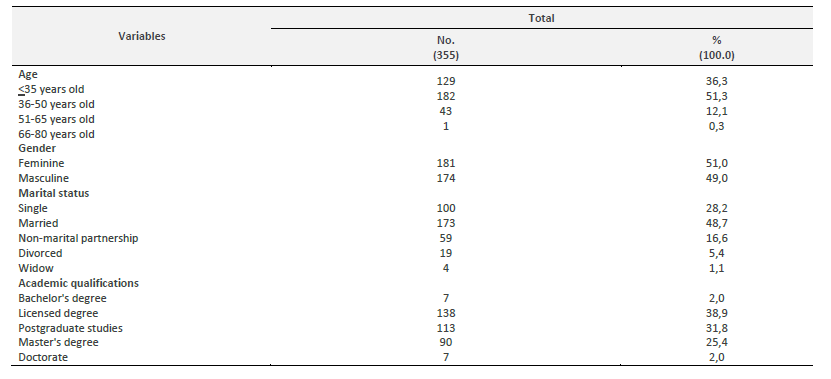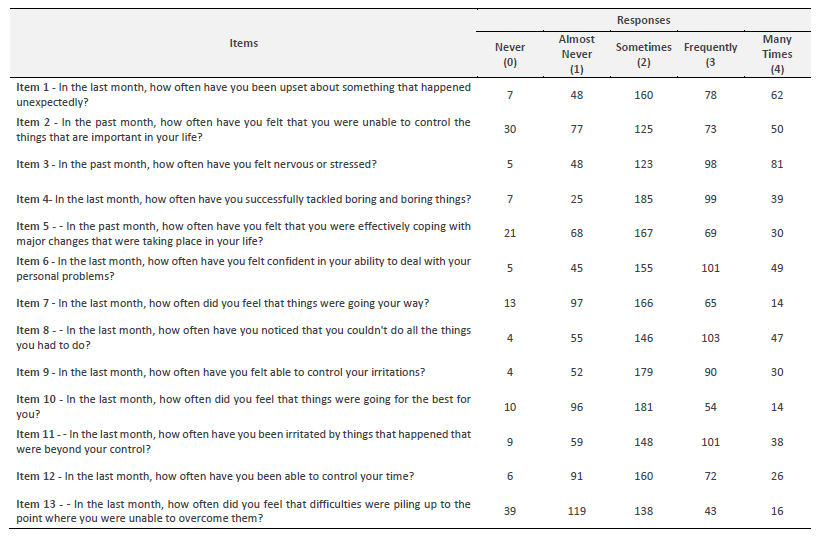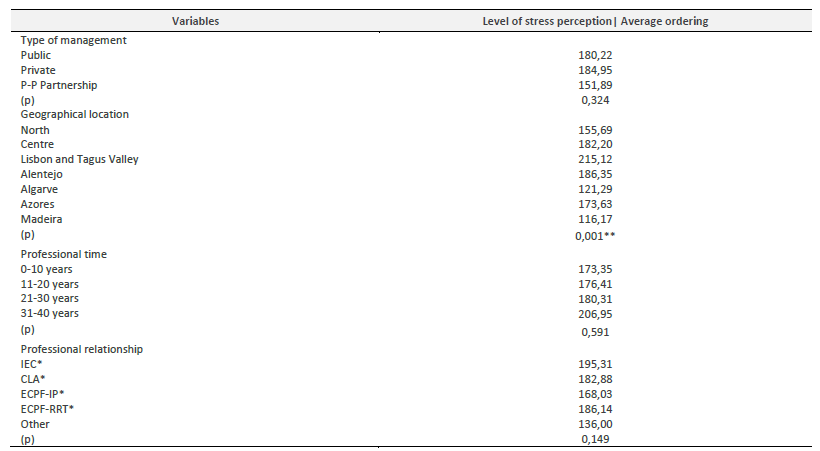Introduction
Coronavirus, known as COVID-19, was identified in December of 2019 in China, in the city of Wuhan and on the 11th of March of 2020 the World Health Organization (WHO) assumed that this outbreak had rapidly turned into a global pandemic (Hu et al., 2020; He et al., 2020). The development of the dissemination originated that Portugal was no exception and the competent entities were obliged to implement restrictive and blocking measures, in an attempt to flatten the contagion curve, similarly to the rest of the world.
The interest in studying the stress profile of Portuguese urgency/emergency Nurses in the context of COVID-19, considering his socio-demographic and professional determinants, arises from the fact of having knowledge of the results of the study “Mental Health In Time of Pandemic” (MH-COVID-19)” (Almeida, et al., 2020), coordinated by the Health Promotion and Non-Transmittable Diseases Department of the Doutor Ricardo Jorge National Health Institute, in collaboration with the Environmental Health Institute of the Medicine Faculty of Lisbon University and with the Portuguese Society of Psychiatry and Mental Health. This study analysed the impact of the COVID-19 pandemic in mental health and wellbeing of the population in general and, of the health professionals in particularly, considering dimensions like anxiety, depression, post-traumatic stress, burnout and resilience, among others.
The pandemic has exacerbated stressors in healthcare systems or services, where burnout among nurses in response to workplace stress is already an epidemic (Duarte t al., 2020).
According recent studies, some health professionals, including nurses who work in the urgency/emergency context, developed psychological suffering, fatigue and exhaustion, while facing the COVID-19 pandemic (Albott et al., 2020; Walton et al., 2020. These health professionals “often face work overload, nurse/patient ratio disparity, resources limitations and imbalance between work and family life, affecting their mental health” (Nunes, 2019, p. 30).
In order to know which socio-demographic and professional variables influence the stress perception level of urgency/emergency nurses in COVID-19 context, was formulated the question “The socio-demographic and professional variables influence the stress perception level of urgency/emergency nurses in COVID-19 context”, in an attempt to find any statistically significant difference between the variables in question.
1. Theoretical framework
At the end of 2019, WHO received alerts of a number of cases of pneumonia in the city of Wuhan, China. It was the starting point of an outbreak generated by a new coronavirus (SARS-CoV2), originator of the coronavirus disease (COVID-19) that, since then, has spread with increasing numbers of cases in other regions of the world. On the 30th of January of 2020, WHO declared a Public Health Emergency of international importance and, on the 11th of March of 2020, the disease became a pandemic (Harapan et al., 2020).
The public health emergencies, although evidencing the fundamental role of the National Health System in the containment of COVID-19, expose the structural deficiencies of the system, particularly, the lack and/or the uneven distribution of the health professionals and of the infrastructures of the medium and high complexity care. Thus, the interaction between the work environment and the human factors seem to have triggered physical and emotional responses in the health professionals, in the specific case of urgency/emergency nurses, which caused a decrease in their mental health and, consequently, of their quality of life.
In the urgency/emergency environment, it is common to find different complementary stressors. The natural stress required to the nurses to give care to the person in critical situation and their relatives, with the complexity that permeates the possibilities of intervention, may turn these health professionals more vulnerable to stress. Nurses deal daily with pain and suffering and are subjected to intense rhythms and long work hours, complex human relationship, lack of materials and a reduced number of professionals (Teixeira et al., 2021).
The COVID-19 pandemic caught the world's attention, specially the consequences of the high risk of stress. The majority of the nurses experiences moderate to elevated levels of stress because these professionals are particularly at risk of becoming infected with COVID-19 and by the healthcare system overload. The nurses that are on the front line, particularly the ones that work in urgency/emergency context, experience an overload of work and psychological stress (Oktovin & Peni, 2021). The complaints, like physical and psychological fatigue are frequently felt due to high number of people infected with COVID-19.
Temsah et al., (2020) refer that pandemic lead to a phenomena without precedents of psychological stress in nurses. The pandemic infectious diseases, like COVID-19, impose a significant level of anxiety and stress in health professionals that take care of infected people, whose main concern is the risk of transmitting the infection to their relatives or develop the disease themselves.
The authors above mentioned refer that usually, nurses are at risk of exposure to highly infectious pathogenic factors in care giving, not only for the exposure to the environment of the person infected or in the contact with biological samples, but also in the lack of Individual Protection Equipment (IPE), which makes them experience high levels of psychological stress. These also need to deal with the unpredictability of their work schedule and higher workload, which oblige them to a bigger adjustment of their private and social life.
The reports of the social media document extreme exhaustion, physical discomfort of long work hours with facial masks and other IPE, fear of contagion and anguish in nurses. This combination of physical and emotional wear in a nursing work force already stressed became a mark of the COVID-19 pandemic (Arnetz, et al., 2020).
The consequences of the stress perception levels in the health of the nurses evaluated during the pandemic, must be seen through a perspective of health and occupational safety. The stress and the burnout were internationally recognized as works risks for the nurses (Pérez-Fuentes et al., 2018) before the pandemic.
Although the research suggests that occupational and personality factors play a role in stress, in 2019, WHO declared stress as an occupational phenomena, in addition of being a medical condition. The beginning of the COVID-19 pandemic increased in the middle of a nursing staff already tense, putting their mental health and well-being at risk (Lai et al., 2020).
2. Methods
2.1 Sample
Quantitative, descriptive correlational study with a cross-sectional approach. 355 nurses who work in urgency/emergency context at national level participated. The sample was of the non-probabilistic, accidental or convenience type.
Data collection occurred between the 1st of February of 2021 and 28th of February of 2021, through the application of a questionnaire of socio-demographic and professional data (ad hoc), with validation of informed consent for the present study by the participants and the Stress Perception Scale (SPS), adapted for the Portuguese population by Pais Ribeiro & Marques (2009), with application authorization date of 10/20/2000, available via Google Forms, to all nurses nationwide.
Ethical principles were fulfilled. Study approved by the Ethics Commission of Polytechnic Institute of Bragança on the 12/11/2020 (Resolution no. 28/2020).
2.2 Data collection instrument
The data collection instrument includes the following measuring instruments:
- Questionnaire of socio-demographic and professional data (ad hoc);
- Stress Perception Scale (SPS), adapted for the Portuguese population by Pais Ribeiro & Marques (2009).
The SPS is, according the authors, a global measuring unit of Stress which proposes to evaluate the grade in which an individual appreciates his life situations like Stress (Cohen, Kamarck & Mermelstein, 1983 in Pais Ribeiro & Marques, 2009). The SPS scale, validated for the Portuguese population is a directional scale with 13 items that operationalizes the Stress Perception variable and that, from the way the sample responds, whose global score results from the sum of the values assigned to each one.
A higher score corresponds to greater perceived Stress in the last month. Being the maximum score of 52 points. There are no cut-off points. The items 4, 5, 6, 7, 9, 10 and 12 are inverted items (Pais Ribeiro & Marques, 2009).
2.3 Statistical analyses
For data analysis, descriptive statistics and analytical or inferential statistics were used. The descriptive analyses enabled to determine the absolute and relative frequencies, measures of central tendency, namely the medium and the dispersion measures like range of variation, the variation coefficient and the standard deviation.
For the inferential analyses was carried out in the first place, the normality test. By the Kolmogorov-Smirnov-Lilliefors (Chart 1), which was applied because, in this sample, with a dimension greater than 30 observations, it allowed to verify that the distribution of data referring to the dependent variable (Stress Perception) is framed within normality (p<0,05). Given this, and through the analysis of figure 1, the existence of a normal or close to normal distribution was assumed.
In the inferential statistics, non parametric, morment tests were used: U Mann-Whitney test and Kruskall-Wallis test.
The investigation questions were tested with a 95% of probability, from where results a level of significance of 5% (α=0,05). The decision criteria for the tests are based in the study of probalitities, confirming the investigation question if the probability is less than 0,05 and rejecting it if greater than this value. The following significance levels were used:
p ≥ 0.05 - not significant
p < 0.05 - significant
p < 0.01 - quite significant
p < 0.001 - highly significant
All statistical treatment was processed using the SPSS program (Statistical Package for the Social Sciences) version 26.0 for Windows.
3. Results
The sample was mostly female (n=181; 51%), predominantly aged between 36-50 years old (51,3%). Regarding the marital status, (48,7%) are married and in the academic qualifications prevailed the graduates with (38,9%).
The majority of the elements of the sample works in the public sector (85,9%), in the north (35,8%), with professional experience time between 11-20 years (40,8%), ECPF-IP* employment relationship (58,6%), rotating work schedule (86,8%), <35 weekly hours (75,2%) and on a full-time job basis (98,9%). As for the service/unit where they work, non-assigned services dominate (22,3%) and participants with the professional category of "nurse" prevail (59,4%).
Chart 3 Professional Characterization of the sample
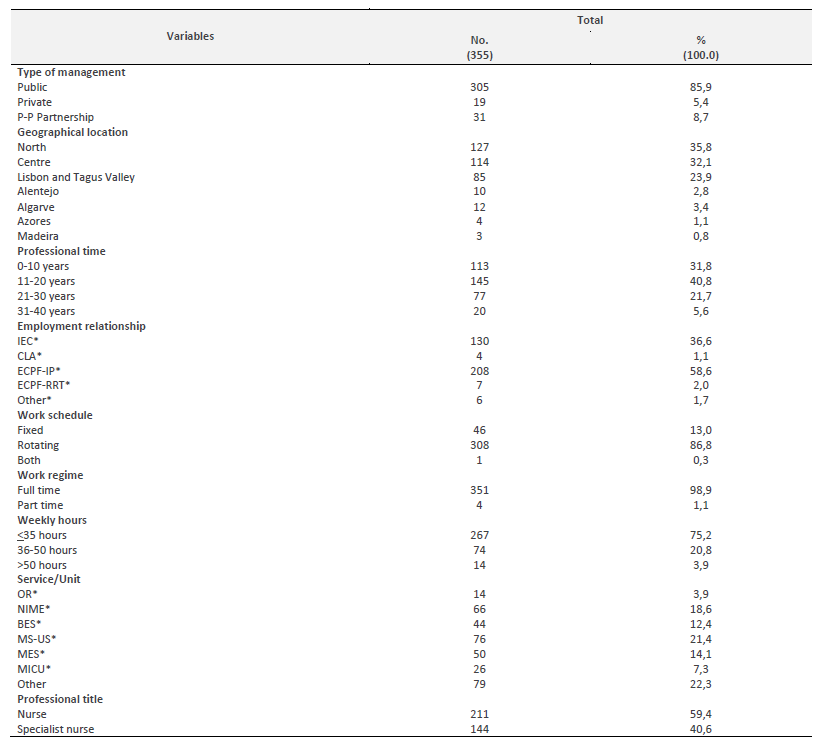
*ECPF-IP: Employment contract of public functions-Undetermined period |*IEC: Individual employment contract |*CLA: Collective Labour agreement | *ECPF-RRT: Employment contract of public functions-right resolutive term | *OR- Operating room | *NIME- National institute of medical emergency |*BES- Basic Emergency service | *MS-US: Medical-surgical urgency service | *MES: Multipurpose emergency service | *MICU: Multipurpose intensive care unit
By analysing table 4, and with regard to the value of the responses given to the Stress Perception Scale (SPS), it is noted that in all 13 items the "Sometimes" answers dominate, with a score of 3. “Never”, were the responses less referred in the first 12 items. As for the 13th item, the response that obtained the lowest frequency of responses was "Many Times".
With the objective to know the influence of the type of management in the stress perception level, it was applied the Kruskal-Wallis test, whose results indicate a higher level of stress by the nurses that work in the private sector, being the ones that work in a public-private partnership institution those who manifest less perception of the stress, however, with the absence of different significant statistics (p>0,05).
Regarding the geographical location versus the stress perception in COVID-19 context, a Kruskal-Wallis test took place, from which a higher level of stress is highlighted by the nurses that work in Lisbon and Tagus Valley. The nurses that work in Madeira Autonomous Region are the ones that manifest less stress perception, with statistical differences quite significant (p=0,001).
As for the influence of professional practice time, a Kruskal-Wallis test was applied, whose data indicate a higher level of stress perception on the part of nurses with longer professional practice, followed by those with between 21-30 years and those with 11-20 years of service. Those with less years of service are those who manifest less perception of stress, however, with no statistically significant differences (p>0,05).
Finally, and with regard to the employment relationship, a Krustal-Wallis test was carried out, which highlights a higher level of stress perception on the part of nurses with a CIT*. Finally, and with regard to the employment relationship, a Krustal-Wallis test was carried out, which highlights a higher level of stress perception on the part of nurses with a CIT*. Finally, and with regard to the employment relationship, a Krustal-Wallis test was carried out, which highlights a higher level of stress perception on the part of nurses with a IEC; followed for those who possess ECPF-RRT* and a CLA*. Those who possess other type of employmet relationship manifest less perception of stress. However, also here with the absence of statistically significant differences (p>0,05).
4. Discussion
The socio-demographic and professional profile of a sample of 335 Portuguese nurses performing urgency/emergency duties indicates a sample mainly female (51,0%), with an average age of 39,25±8,8 years old, with the predominance of the age group of 36-50 years (51,3%). Most nurses are married (48,7%), licensed (38,9%), having an average professional time of 15,29±8,92 years and an average weekly working time of 39,39±6,08 hours. Most participants work in the public sector (85,9%) in the north (35,8%), following the ones who work in the centre area (32,1%) and in Lisbon and Tagus Valley (23,9%). Those with professional experience time between 11-20 years stand out, who have ECPF-IP* with 58,6%, practicing rotating hours, with ≤35 hours/week. As for the service/unit where they work, in addition to non-assigned services (22,3%), those working at MS-US* and NIME* (21,4%; 18,6%, respectively) and with the professional category of "nurse" stand out (59,4%). These data, for the most part, corroborate the socio-demographic and professional profile of a sample of 453 nurses who participated in the study by Cui et al. (2021), where there was a prevalence of women (96,47%), but with a slightly lower mean age (M=33,15±8,38 years) and mean length of professional experience (M=11,33±9,25 years) compared to the nurses in the present study. In that study, the prevalence of licensed nurses (38.7%) and with an average weekly working time of 37.29±6.01 hours was also recorded, results corroborated in the present study.
Considering the objective of the current study, to verify if the socio-demographic (age, gender, marital status and academic qualifications) and professional (type of management, geographical location, professional time, professional relationship, schedule, work regime, weekly hours, service and professional title) variables influence the level of stress perception of the urgency/emergency nurses in COVID-19 context, it was stated that younger nurses (≤35 years old), male, divorced and the nurses with master’s degree would be mainly subjected to stress. On the other hand, the geographical location where these work interfered on the stress perception, registering higher level of stress in nurses that work in Lisbon and Tagus Valley. The nurses that work in Madeira Autonomous Region manifested less stress perception, with quite significant statistical differences (p=0,001). No statistically significant differences were recorded with regard to the type of management of the service location, length of professional practice and employment relationship. However, the average ranking values indicate a higher level of stress on the part of nurses working in the private sector, with longer professional experience, followed by those with between 21-30 years and by those with between 11-20 years of service and by nurses with an IEC*; followed by those with a ECPF-RRT* and a CLA*. In the studies found, nurses with less time in professional practice were those who manifested a higher level of perception of stress (Jijun et al., 2020; Fernandez et al., 2020), which was not corroborated in the sample of the present study. These studies indicate that younger nurses are the most predisposed to stress, which is justified by the fact that younger individuals with less professional experience still do not have enough time to formulate effective coping strategies to deal with occupational stress and, therefore, they are more vulnerable.
According Urzal et al. (2021), the percentage of Portuguese nurses during the COVID-19 pandemic (20,4%) with symptoms of anxiety, stress, depression and post-traumatic stress disorder comes close to studies carried out in China in February (27,39%) and June (20,87%) of 2020 (Huang, et al., 2020; Zhang & Ma, Z.F., 2020). However, the use of different evaluation instruments in the several studies complicates a comparative analyses with the Portuguese reality in terms of mental health of the nurses during the pandemic. Pandilha and Silva (2020) state that the pandemic was at the origin of changes in the professional practice and in the personal life of nurses, with some of them even having to change residence during the pandemic, taking them away from their family life, which is corroborated in the present study, where the married or cohabiting nurses were more likely to develop higher levels of stress. The most evident psychological manifestations in the literature on nurses during the pandemic were higher levels of stress, exhaustion and depressive mood, strong psychological effects and difficulty in coping with the situation, high levels of anxiety, fear and psychological suffering (Fernandez et al., 2020; Zerbini et al., 2020; Aksoy & Koçak, 2020).
The COVID-19 pandemic has drawn the world's attention, especially with regard to the risk of stress. Most nurses must have experienced moderate to high levels of stress, as these professionals are particularly at risk of being infected with COVID-19 and by the burden on the healthcare system.
Conclusion
Nurses who work in an urgency/emergency context are the main health professionals in an epidemic and have the most contact with patients. These faced many challenges during the COVID-19 epidemic, being directly at risk, triggering higher levels of work stress (Zakeri et al., 021).
It was in this context, and taking into account personal experience, that the present study was developed, with a sample of 355 Portuguese nurses working in urgency/emergency, with an average age of 36,25±8,89 years. The evidence found allowed us to answer the research question, having concluded that the only professional variable with statistically significant interference in terms of the perception of stress of urgency/emergency nurses in the context of COVID was the geographical location where they work, being higher the level of stress of the nurses working in Lisbon and the Tagus Valley. It was also concluded that there was a higher level of stress on the nurses working in the private sector, with longer professional experience, followed by those with between 21-30 years and by those with between 11-20 years of service and on the nurses with an IEC*; followed by those who have a ECPF-RRT* and a CLA*, although without statistically significant relevance. Although the socio-demographic variables did not reveal statistically significant differences, it was found that younger nurses (≤35 years old), male, divorced and nurses with a master's degree, were the ones who presented a greater perception of stress during the COVID-19 pandemic. A systematic review with a meta-analysis focusing on the prevalence of depression, anxiety and stress during COVID-19 concluded that almost a third of nurses had depression, anxiety and stress during the COVID-19 pandemic. Anxiety and depression were more reported among female nurses, while stress was more prevalent in male and younger nurses (Nadeem et al., 2021). The psychological effects of the pandemic situation on nurses must be urgently evaluated, understood and controlled. Understanding and assessing their effects are essential for promoting and protecting nurses' well-being and emotional resilience, as they can directly affect the quality of healthcare provided. Despite the growing scientific evidence about health professionals affected by high levels of stress that increased significantly during the pandemic, there was a shortage in the literature on the topic addressed in urgency/emergency nurses, which resulted in the main limitation of this study. Therefore, it is suggested that this study be replicated in order to understand how these professionals adapted to work-related stress during a pandemic, and it is also interesting to investigate their cognitive response after a pandemic crisis, in order to develop preventive measures to mitigate higher levels of stress and help in coping.















